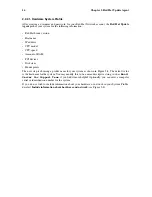
Introduction
iii
prompt
A prompt, which is a computer’s way of signifying that it is ready for you to input something,
will be shown in this style. Examples:
$
#
[stephen@maturin stephen]$
leopard login:
user input
Text that the user has to type, either on the command line, or into a text box on a GUI screen, is
displayed in this style. In the following example,
text
is displayed in this style:
To boot your system into the text based installation program, you will need to type in the
text
command at the
boot:
prompt.
Additionally, we use several different strategies to draw your attention to certain pieces of information.
In order of how critical the information is to your system, these items will be marked as note, tip,
important, caution, or a warning. For example:
Note
Remember that Linux is case sensitive. In other words, a rose is not a ROSE is not a rOsE.
Tip
The directory
/usr/share/doc
contains additional documentation for packages installed on your
system.
Important
If you modify the DHCP configuration file, the changes will not take effect until you restart the DHCP
daemon.
Caution
Do not perform routine tasks as root — use a regular user account unless you need to use the root
account for system administration tasks.
Summary of Contents for NETWORK BASIC - USER REFERENCE GUIDE 4.0
Page 1: ...Red Hat Network Basic User Reference Guide 4 0 ...
Page 14: ...6 Chapter 1 What is Red Hat Network ...
Page 42: ...34 Chapter 2 Red Hat Update Agent ...
Page 46: ...38 Chapter 3 Red Hat Network Notification Tool ...
Page 66: ...58 Chapter 5 Red Hat Network Daemon ...
Page 68: ...60 Chapter 6 Using Red Hat Network with Red Hat Linux 6 2 ...
Page 81: ...Chapter 7 Red Hat Network Registration Client 73 Figure 7 15 Text Mode Welcome Screen ...
Page 82: ...74 Chapter 7 Red Hat Network Registration Client ...
Page 88: ...80 Glossary ...
Page 92: ......








































